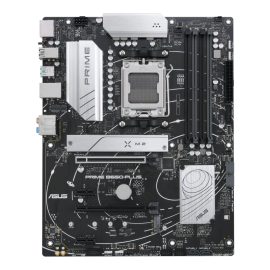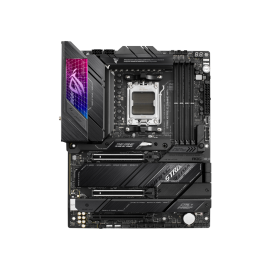-
ASROCK Motherboard A620M-HDV/M.2+ AMD Supports AMD Socket AM5 Ryzen 7000 Series Processors,Supports DDR5 7200+ MHz (OC)
Special Price SAR 660.04 was SAR 810.84 -
MSI MAG X670E TOMAHAWK WIFI Motherboard Supports AMD Ryzen 8000/ 7000 Series Desktop Processors Socket AM5
Special Price SAR 1,390.84 was SAR 1,854.84
AMD Motherboards
Modern world high-performance computing and desktop systems operate on AMD motherboards. They have the circuitry and capabilities required to host the AMD Ryzen and Threadripper on AM4 and AM5 platforms. AMD motherboards come with high compatibility, broad sets of features, and compliance with the latest standards, like DDR5 memory and PCIe 5.0. This flexibility, performance, and adaptibility offer future-proofing. AMD provides specialized solutions regardless of whether one wants to build a mini ITX small form factor system, a gaming machine, or a multi-GPU computing model.
AMD type of motherboard with chipset available to include A620, B650, B650E, X670, X670E, X870, and X870E. They are appealing to both novice builders and serious enthusiasts as well as professional creators. AM4 motherboards: support Ryzen 3000 and 5000 series Processors, known to be stable and AM5 motherboards: support Ryzen 7000, 8000 and 9000 series and will be more powerful, having a PCIe 5.0 support and DDR5 memories. Such platform flexibility makes sure that local builders and global builders can select the boards they need and can afford, without compromising compatibility and upgrade potential.
Socket and chipsets alternatives
AM4 Motherboards AM4 motherboards can work on CPU AM4 and run operating modules of Ryzen 3000 and 5000 series. They tend to include DDR4 memory, PCie 4 lanes and various M.2 slots. By comparison, AM5 motherboards rely on socket LGA 1718, and carry Ryzen 7000 and subsequent Zen-based CPUs. B650 and X670 chipsets are AM5 platform offerings that introduce DDR5 and PCIe 5.0 support to systems running AMD systems. The newer “E” models (B650E, X670E, X870E) guarantee full compatibility with PCIe 5.0 of GPUs and storage, and add support of USB 4.0 and more memory tuning. The increasingly popular mid-level chipsets such as B650 chipsets have extensive feature syntax, and the highest-quality X670 and X870 have wide overclocking, two-way cluster, and peerless networking.
System designs and the form factors
Motherboards carrying manufacturing with AMD support can be in ATX, Micro‑ATX, Mini‑ITX, or E‑ATX. ATX boards have good PCIe connectors, several M.2 storage connections, and four DIMM openings. Micro ATX boards have capabilities of expansion and also they are compact. Mini-ITX boards offer high-end with a small form factor like PCIe 5.0 x16 slot, two M.2 storage, Wi-Fi 6E/7 and strong VRMs. E-ATX boards go all the way to fully-loaded rigs using multiple GPUs, large storage and VRM-laden CPU-overclocking features. These alternatives serve constructors who need small gaming computers or complete workstations in every location.
Memory configuration and execution Memory configuration and performance Most computers have a refresh rate of 31.25MHz, whereas 40MHz is standard.
Modern AMD motherboards use AM5 platforms that allow DDR5 memory, using speeds up to – and exceeding - DDR5-8000. The profiles of AMD EXPO make the process of overclocking and compatibility faster in regard to memory. In premium boards, it may have an improved PCB layout, memory trace optimization to provide stable overclocked operation. DDR4 memory kits using AM4 boards continue to be popular through DDR4‑3600, and offer good value on mainstream systems that require solid performance.
Expansion features and PCIe lanes
High-end chipset and motherboards in the next-generation AMD provide PCIe 5.0. That gives a headroom to the future GPUs and NVMe storage drives. B650E is capable of PCIe 5.0 support in storage whereas X670E and X870E offer PCIe 5.0 lanes with graphics cards and storage devices. A majority of them have two or three M.2 slots and they support either PCIe 5.0 or PCIe 4.0 NVMe SSDs and a number of SATA III connectors. These growth options will fulfill the requirements of faster data, increase game collection, and storage upgrades in the future.
Audio features, networking and USB features
The AMD motherboards are flexible on I/O connection to be compatible with the international markets. The selection of networking is between 2.5Gb Ethernet and 10Gb or multi-gig LAN at the top of the range, and a range of built-in Wi-Fi 6E or Wi-Fi 7 is the wireless performance. These characteristics make this device suitable in terms of low-latency gaming and swift file transfer. Premium boards also add USB 4.0 and USB 3.2 Gen 2x2, Type-C ports. Audio plays through Realtek ALC1200 codecs to top-end ALC4080 chips, and it includes a dedicated amp circuit board and isolated PCB sections in the game and content generation.
VRM design and power delivery Power delivery Fast, sharp and precise power delivery VRM design
Power delivery systems range 8+2 to more expensive models with 18+2 or 20+2. High end boards feature VRM heatpipes, heatpipes and heatsinks, and thermal cooling to support overclocking and CPU with many cores. The active fans or larger heatsinks are frequently involved in cooling the chipset and the more powerful power stages increase system stability. These high‑end VRMs and cooling are condensed into small PCs using mini ‑ITX motherboard in short PC cases.
The tools of BIOS functionality and tuning existence
AMD motherboards provide advanced/tweaking BIOS system. UEFI BIOS contains EZ Mode, secure boot, memory profiling, overclocking presets and BIOS flashback. BIOS destroys corruption through the use of dual BIOS chips. Tuning of DDR5 is guaranteed of ease through AMD EXPO support. Board makers additionally come with fan control software package, RGB illumination, network priority, performance tracking, and single-command optimization. Other tools find use among rookie PC builders as well as master overclockers across the globe.
Use cases such as gaming and creative and compact use cases
Gaming PCs leverage high refresh VRR displays, PCIe 5.0, speedy storage, wireless 7 connectivity, and audio capabilities into an engrossing game experience. Triple M.2 slots, USB 4.0, multi-GPU, and expo memory make editing and rendering content to make it appealing and attractive on content. Small-form-factor builds are based on the Mini-ITX boards with full-size feature in a smaller size. Workstation type boards feature ECC memory support, multi lane PCIe expansion and professional reliability making them the right choice on the global office and production floors.
Purchasing advice and construction approach
Among the platforms, builders need to pick the correct one: AM4 based on low-cost systems, AM5 with a future-proof performance in mind. The choice of chipsets depend on feature requirements: B650/B650E to mainstream, X670/X670E or X870/X870E to overclocking and future expandability. Case size and upgrade requirements should be in line with form factor. DDR4 vs DDR5 tradeoffs determine the memory choice. Make sure the motherboard has needed PCIe lanes, M.2 connector, USB, network, and audio alternatives. Answer: Evaluate the quality and cooling of VRM in terms of CPU loading and ambient temperatures. Case ventilation and plan PSU to allow board to consume its power.
The opinions of the community and trustworthiness
The AMD motherboards have also been praised with providing BIOS stability, performance tuning, connectivity features, and sound build quality. The new capabilities such as BIOS recovery toolset and improvement of voltage control are consistently updated through-sbc-firmware. Premium boards get credit on the aspect of stable overclocking, compatibility with memory, and audio. Budget boards are cost-efficient and offer good standards to cost-sensitive builders who have to upgrade.
Future trend and technology forecast
Important developments are an increase in DDR5 memory, expanded PCIe 5.0 support, inclusion of Wi-Fi 7, USB 4.0, the use of AI in BIOS tuning, and small high-performance form factor boards. AMD EXPO memory tuning is growing and also AMD is maturing platform support to Zen5 and so on. These advances offer promising prospects of the future AMD motherboards being versatile and competitive even across the globe.
Conclusion
In the international markets, AMD motherboards give a well-founded foundation to PC. They support gaming, workstation builds, creative work and compact designs based on their well-rounded chipset choices, future-proof connectivity, good VRM and BIOS capabilities, and flexible form factors. Whether you are constructing a performance monster machine of today, or setting up for the deployments of the future, the AMD motherboards will provide the point of freedom, stability, and set-up that is highly sought by many constructors.
Chat With Us
- Guest Chat
- Login Chat














